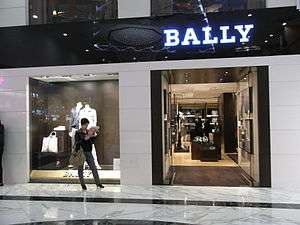Bally Shoe
|
| |
| Industry | Fashion |
|---|---|
| Predecessor | CF Bally & Sons |
| Founded | Schönenwerd in the Canton of Solothurn, Switzerland 1851 |
| Founder | Carl Franz Bally and Fritz Bally |
Key people | Frédéric de Narp (CEO)[1] |
| Parent | JAB Holding Company |
| Website |
www |

The Bally company was founded as "Bally & Co" high fashion in 1851 by Carl Franz Bally (1821–1899) and his brother Fritz in the basement of their family home in Schönenwerd in the Canton of Solothurn, Switzerland.
History
Bally was founded by Carl Franz Bally. His original family business was the manufacture of elastic ribbon.
During a business trip to Paris in 1849, Carl Franz wanted to buy his wife some lace-up booties - the popular shoe of the day. Unable to recall her exact size, he decided to buy twelve pairs in a range of sizes, knowing that one would certainly fit. Upon visiting the Parisian factory where the booties were made, he noticed that each shoe featured buttons with elastic closures similar to the kind his family produced in Switzerland. Inspired by the possibility of creating more jobs and improving the lives of local residents, he decided to expand his business into shoe production. Together with his brother Fritz, Carl Franz employed designers to assist and together, they began producing shoes made entirely by hand in the cellar of his Schönenwerd home.
The Bally Company was established in Schönenwerd in 1851 and three years later, the first factory located in the village centre was built. In 1854, Fritz Bally retired. By the 1870s, Bally was recognised as a footwear industry leader. The company’s name changed to CF Bally, and then to CF Bally & Sons when the brand’s founding pioneer handed the company reins to his sons in 1892. Carl Franz died in 1899 but undeniably passed on his pioneering spirit to his sons. Bally grew internationally and opened stores in Geneva and Montevideo (Uruguay) in 1870, followed by Buenos Aires (1873), Paris (1879) and London (1882). In the 1880s, Bally was also one of the very first European luxury goods brands to open in post-reform and opening China. By now the brand had also extended its offering to include clothing, handbags and leather goods for both men and women (1976), and in 1990 would become truly global, opening in Japan, Hong Kong, Singapore, Australia, Malaysia, Saudi Arabia, Brazil, Lebanon and Turkey.
Bally is currently under the leadership of CEO Frédéric de Narp (November,2013), with Pablo Coppola as Design Director (February, 2014) and parent company JAB Holdings at the helm.
In 2008 TPG Capital sold Bally International AG to Vienna, Austria-based Labelux Group, a luxury goods holding firm which also owns Jimmy Choo Ltd. and was founded by the German billionaire Reimann family as part of the family’s investment arm Joh A. Benckiser.[2]
Today, the company is headquartered in Caslano, Ticino, Switzerland and run by JAB Holdings. The company announced that Frédéric de Narp, a former executive at Harry Winston, would become its chief executive officer in November 2013.[1][3]
Boutiques
Australia
Bally has boutiques in Sydney (Westfield Shopping Town), Melbourne (Collins Street), Doncaster, Perth, and Sydney International Airport.
Asia
- Mainland China: 50 boutiques[4]
- Hong Kong: 7 boutiques[5]
- Japan: 25 boutiques[6]
- India: 1 boutique (New Delhi)
- Indonesia: 2 boutiques
- Malaysia: 1 boutique (Kuala Lumpur)[7]
Europe
- Austria: Vienna and outlet in Parndorf
- France: Paris and Nice
- Germany:Berlin, Hamburg, Munich, Ingolstadt and Düsseldorf.
- Netherlands: Amsterdam Roermond Outlet
- United Kingdom: London New Bond Street and outlets in Bicester and Hackney[8]
Middle East
- Bahrain: (Jashanmal Department Store in Manama)
- Kuwait: 3 boutiques
- Saudi Arabia: Olaya Street in Riyadh
- United Arab Emirates: Abu Dhabi and Dubai
North America
Bally has 13 boutiques in the United States,[9] including: Atlanta, Beverly Hills, Boston, Costa Mesa, Honolulu, Houston, Las Vegas, McLean, and New York City.
References
- 1 2 Conti, Samantha (10 January 2014). "Frédéric de Narp Talks Bally". WWD. Retrieved 10 January 2014.
- ↑ Labelux Group acquires Bally International AG from Texas Pacific Group Inc - Thomson Financial Mergers & Acquisitions - AlacraStore.com
- ↑ Conti , Samantha (19 September 2013). "Frédéric de Narp Heading to Bally". WWD. Retrieved 19 September 2013.
- ↑ Bally China boutiques
- ↑ bally.com Hong Kong boutiques
- ↑ bally.com Japan boutiques
- ↑ bally.com Malaysia
- ↑ bally.com United Kingdom
- ↑ bally.com United States
| Wikimedia Commons has media related to BALLY. |